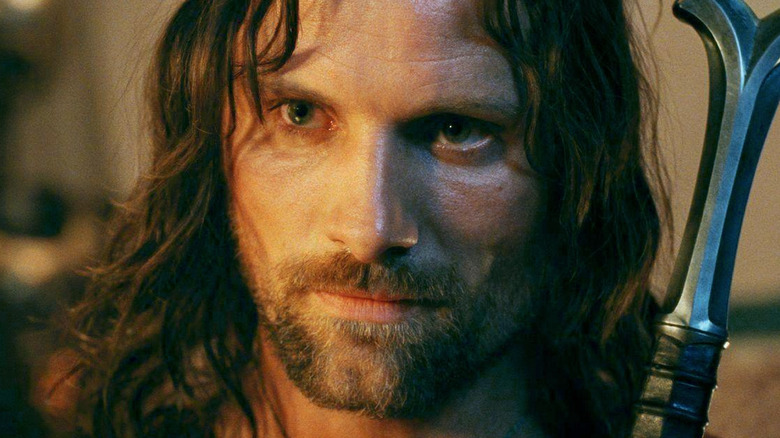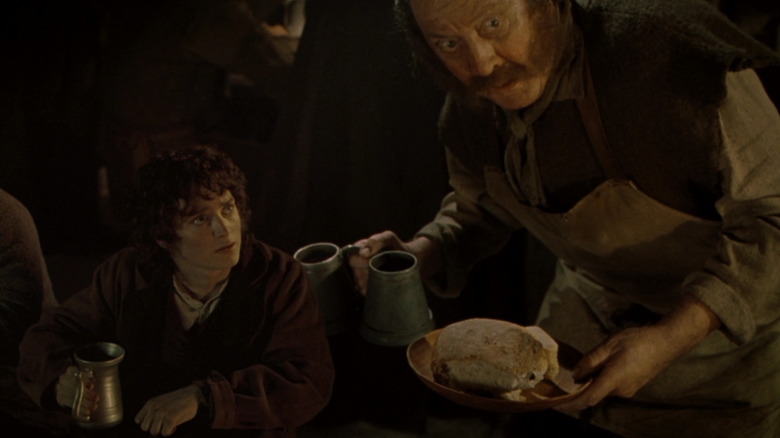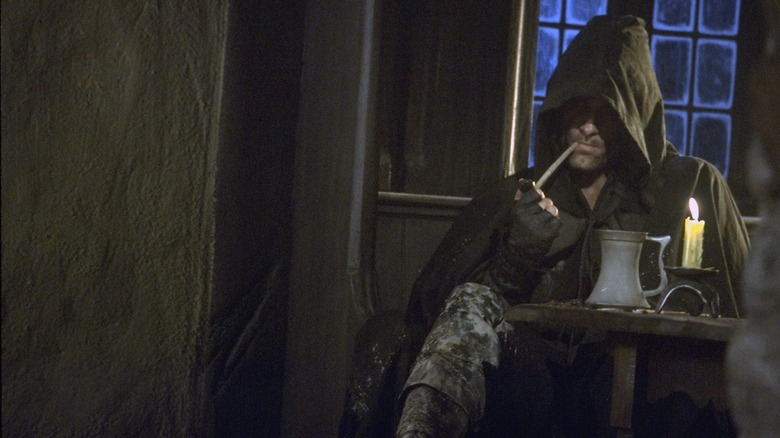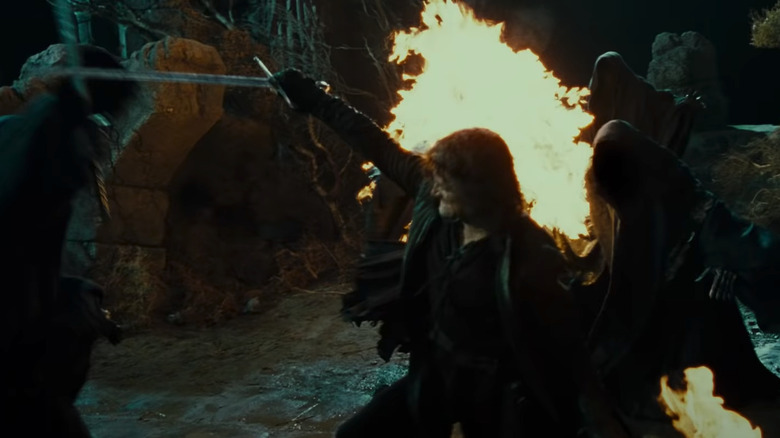Lord Of The Rings' Aragorn Was Originally Supposed To Be A Hobbit (Kind Of)
Aragorn is an iconic presence in "The Lord of the Rings." The larger-than-life character is a scrappy-yet-noble hero whom everyone can get behind. He's the chief of the Rangers who, among other things, guard the Shire. He's an exiled royal who is patiently waiting to claim the kingship of Gondor (along with its defunct sister kingdom of Arnor). By the time the story starts, Aragorn has also traveled the continent of Middle-earth, where he has saved Gondor under a different alias, fought alongside the Rohirrim, had adventures with Gandalf, and fallen in love with the half-Elven daughter of Elrond. Suffice it to say, the son of Arathorn is a complicated and captivating part of J.R.R. Tolkien's lore who plays a crucial role before, during, and after the "Lord of the Rings" plot.
Over the years, there have been a lot of different iterations of the character, too. Along with the author's officially published version, Viggo Mortensen also brought his own interpretation of Strider to the silver screen. This more vulnerable, down-to-earth rendition of Aragorn is accessible and relatable (as opposed to the much loftier, inaccessible version in Tolkien's writings). Ralph Bakshi's animated adaptation also developed its own take on the character, as have multiple video games developed over the years.
Both the vast depth and different variations of Aragorn have taken decades to develop. Some of this process obviously took place as other artists have interpreted the source material over the years, but figuring out just who this mysterious Ranger is goes back even further than that. It's an elusive and complicated creative journey that starts all the way back with the author himself. That's right. Even Tolkien wasn't exactly sure who Aragorn was the first time he "met" him.
Tolkien was originally shocked by Aragorn
In a letter written in June of 1955 (right before "The Return of the King" was published), J.R.R. Tolkien explained that while writing the story, "I met a lot of things on the way that astonished me. Tom Bombadil I knew already; but I had never been to Bree. Strider sitting in the corner at the inn was a shock, and I had no more idea who he was than had Frodo." This isn't just a cutesy way for Tolkien to say he fleshed out Aragorn's story as he went along. It's referencing a massive shift that took place over multiple years and drafts.
In fact, in the author's original vision for the character, the first time Frodo and company bumped into Aragorn in Bree, he wasn't called Aragorn ...and he wasn't even a Man.
Tolkien didn't write the "Lord of the Rings" trilogy in one sitting or even a few sessions. On the contrary, the story came together over years of writing and rewriting. This painfully laborious, never-ending evolution is how Tolkien got things done. He was always reviewing, adjusting, and reworking his world. Many elements of the story remained the same or at least similar during this process. But a lot of major characters changed or were even fully replaced — including the ranger who joins the Hobbits shortly after they leave the Shire on their way to Rivendell.
Trotter, the proto-Aragorn ...Hobbit?
Early on in J.R.R. Tolkien's composition of "The Lord of the Rings," Frodo's character was named Bingo Bolger-Baggins — thank goodness that one got changed. When Gandalf prematurely leaves the Shire before Bingo is ready to start his quest, the Wizard does so because he receives a message from a fellow named Trotter. Later on, Bingo/Frodo arrives at Bree, where he meets a mysterious ...Hobbit. His name? You guessed it. Trotter.
The book "The Return of the Shadow" contains this early draft, and it explains, "The text goes on to explain the appearance of this proto-Aragorn, saying thusly, "He had an enormous mug (more like a jug) in front of him, and was smoking a broken-stemmed pipe right under his rather long nose. He was dressed in dark rough brown cloth, and had a hood on, in spite of the warmth, – and, very remarkably, he had wooden shoes!"
Tolkien mulled over who this mysterious Hobbit was. At one point, he considered making him Bilbo's long-lost cousin. At another time, he nearly made the character Bilbo himself. Eventually, the dominant version Tolkien opted for in the early drafts was Peregrin Boffin, one of Frodo's cousins, although he went by the nickname Trotter. Throughout this exploration of the Trotter persona, the character very much so remained in the support role that Aragorn would eventually fill. He helps Gandalf track Gollum, guards the Shire, and gives Frodo and his friends a hand as they dodge Black Riders and try to get to Rivendell. He even joins the Fellowship of the Ring later on.
Becoming Aragorn
Before we dive into the transition from Trotter to Aragorn, let's quickly address the name itself. If you're wondering where "Trotter" comes from, it has to do with the sound of the character's feet. J.R.R. Tolkien's son, Christopher, guessed that his father planned to reveal that Trotter wore wooden shoes (an unusual act for a thick-soled, hairy-footed Halfling) due to the long-term effects of injuries to his feet — chronic wounds that he received while being tortured by Sauron. It's a dark backstory for a Hobbit, to say the least.
It's also worth pointing out that Trotter wasn't even technically the first version of the character. If you back up even further, Christopher Tolkien tells us in the book "The Treason of Isengard" that Tolkien very briefly debated making Trotter a disguised Elf from Rivendell — a version of the character that he even considered detailing in his own spin-off novel. But that idea was quickly abandoned, and the Hobbit version became the primary option for the early phases of the story's development.
Tolkien went back and forth about the specifics of Trotter's race and heritage. The Trotter persona managed to survive multiple manuscripts before it was officially replaced by the Aragorn that we all know and love. Even then, many of the aspects of Trotter continued to live on in Strider, the clever, weather-beaten old Ranger. While the development of the exiled king is obviously a powerful part of the final version of the story, it's fun to speculate how differently "The Lord of the Rings" would have gone if it had been Trotter clickety-clacking along by Frodo's side on the journey to the Crack of Doom.



